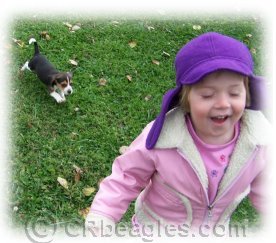|
|
|
Training Your Puppy To Lead / Walk On A LeashUntil a puppy is 8 weeks old, I believe it is best to not use a collar and leash. This is due to lack of physical maturity of his bones and muscles, and because his learning abilities are not well prepared for training earlier than this time. Most good breeders don't let their puppies leave until around 8 weeks of age (and in toy breeds, 10 or 12 weeks), which means that your puppy may not have been leash trained prior to you picking him up. For large breeds, this may not be the case. But small/medium breeds of dogs are small enough at 8 weeks that the puppy can easily be caught if he decides to move away from his handler. Therefore, leash training was also not essential during the first 8 weeks of his life. The Goal: A Well-Trained Dog That Walks On A Loose LeashLeash training a puppy requires allowing the puppy to get accustomed to a collar, a leash, and then teaching him to walk with you--without pressure--on a short leash. First and foremost, keep the puppy's safety in mind:
Step One: Let the puppy become accustomed to a collar. Allow the puppy to wear a collar that is safe and correctly fitting for a day or two while supervised. At first, he will try to scratch the collar and will shake his head, as it feels odd and may tickle. This does not mean the puppy has ear mites! ;-) The collar is simply a new sensation, and the puppy will try to eliminate that sensation by scratching, rolling, or running away from it. Remember to take the collar off if the puppy could find anything that would catch the collar and choke or hang him! Most experts even insist on removing the collar while the puppy is in his crate/kennel. The collar should only be worn while the puppy/dog is supervised. Step Two: Let the puppy become accustomed to a leash. Attach a short leash to the puppy's collar, and let him drag it around for a while, supervised. As the leash brushes against objects, it will provide more resistance, which helps the puppy become accustomed to pressure. Again, make sure the leash can't catch on anything that could hang or choke the puppy. Step Three: Teaching the puppy to walk with you. Periodically, pick up the leash and walk with the puppy. If the puppy walks along with you, stop and reward him. Still without applying pressure, encourage the puppy to follow you by calling him as you walk. Use your body language, voice, and even treats such as a few kibbles from a soon-to-come meal. Praise each success. Problems Pulling: A problem will certainly occur where the puppy tries to pull back. Some experts believe you should let him go at this time. Others believe you should stand steady and let the puppy teach himself that pulling is less comfortable than following his person. You should research (see the links at the bottom of this page) and determine which philosophy works best for you and your puppy. If the puppy tries to pull, drop the leash only if you can do it immediately. If you wrestle for a second or two and then drop the leash, you will teach the puppy that when he pulls, you will let go and give him freedom. This can lead to an out-of-control dog in the future. On the other hand, don't get into a game of tug of war, as this could be considered a game to the puppy. Tug of war at this age is also a game that can cause puppies to become aggressive and dominant. Proper response to a pulling puppy requires good timing. If the puppy begins to pull, stop, hold firm, but don't pull him toward you. Let the puppy do the pulling, and don't make a game of it. The puppy will most likely accidentally take a step toward you, and that releases the pressure. Take quick advantage to call the puppy to you. The puppy will hopefully realize that when he took a step toward you, the pressure stopped. Good timing with this will help the puppy develop a learned reaction to pressure: to step toward the pressure in order to relieve it. Initially, one step should be praised. As the puppy gets better and better, ask for two steps. Then three, etc. It is important to condition the puppy to respond to pressure by immediately moving toward the person holding the leash. If you don't want to use pressure as a method to ask the puppy to move forward, you can spend time teaching the puppy to come to you, and then keep working on using your voice and body language, treats, or whatever method is needed to teach him to heel. Sooner or later, the puppy will test the leash by pulling. But a better foundation in following the handler without a leash will make this a quicker step to pass successfully. Chewing on the Leash: If the puppy tries to persistently chew on the leash, you can get some Bitter Apple spray or a similar anti-chewing product to spray the leash with. Handler Gets Tangled In The Leash: If the puppy wraps the leash around your legs, give him less slack or get a leash that is shorter.
Links For Additional Tips on Leash Training Puppies
|
|
|
|
|
|
|
|
|
|
|
| HOME * PUPPIES FOR SALE * APPLICATION FORM * ABOUT US * GUARANTEES * SITE MAP | |
|
Last Updated |
|
"There is no psychiatrist in the world like a puppy licking your face."
-Ben Williams











